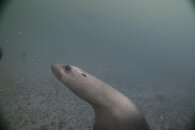I’ve lost 12 lbs over the winter and continue to lose. I now have to figure out my weighting again. Last time I dove my CCR with heavy undies was late October. I needed 26 lbs with one AL40 for dilout (Kiss Spirit). I’m switching to a pair of LP50s, which seems to take me down to 22lbs.
Now that I’m down 12 lbs of bioprene, how much less should I be able to shed?
Now that I’m down 12 lbs of bioprene, how much less should I be able to shed?






